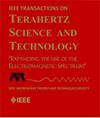Design of a D-Band Multiply-by-9 Frequency Multiplier Chain in 16 nm p-FinFET Technology With Waveform Modeling
IF 3.9
2区 工程技术
Q2 ENGINEERING, ELECTRICAL & ELECTRONIC
IEEE Transactions on Terahertz Science and Technology
Pub Date : 2025-07-14
DOI:10.1109/TTHZ.2025.3588765
引用次数: 0
Abstract
This work presents the design and analysis of a compact D-band × 9 frequency multiplier chain, using taiwan semiconductor manufacturing company limited (TSMC) 16 nm technology with the radio frequency (RF) p-FinFET device. The unique high16 nm p- finet技术中d波段乘9倍频倍频链的设计及波形建模
本研究采用台积电(TSMC)的16nm技术,设计并分析了一种紧凑的d波段× 9倍频链,用于射频(RF) p-FinFET器件。p-FinFET器件独特的高$\mathbf {f_{\max}}$特性为本设计奠定了基础。为了适应fin - field-effect transistor (FinFET)器件中的短通道效应,提出了一种时域双箝位分段线性模型来分析三倍频器件的电流波形,通过与仿真结果的比较,证明了该模型能够准确地预测FinFET的谐波产生行为。为了提高效率,还研究了最优负载阻抗和3f_{0}$的匹配条件。该倍频链由一个用于单差转换和失配补偿的无电感有源平衡器、两个三倍频单元、一个级间放大器和输出端的两级驱动放大器组成。在设计三倍频器时,将该模型应用于寻找最优偏置条件。在两种偏置条件下测量了所提出的乘数;前者的转换增益为1.6 dB, $\mathbf {P_{sat}}$为-2.8 dBm,谐波抑制比为44 dBc,同时消耗58 mW直流功率。第二个偏置点在4.7和1.8 dBm, 102 mW直流功率下实现更高的转换增益和$\mathbf {P_{sat}}$。该乘法器芯片的核心面积仅为0.068 $\mathbf {mm^{2}}$,在1 mhz频偏下相位噪声衰减为19.8 dB。
本文章由计算机程序翻译,如有差异,请以英文原文为准。
求助全文
约1分钟内获得全文
求助全文
来源期刊

IEEE Transactions on Terahertz Science and Technology
ENGINEERING, ELECTRICAL & ELECTRONIC-OPTICS
CiteScore
7.10
自引率
9.40%
发文量
102
期刊介绍:
IEEE Transactions on Terahertz Science and Technology focuses on original research on Terahertz theory, techniques, and applications as they relate to components, devices, circuits, and systems involving the generation, transmission, and detection of Terahertz waves.
 求助内容:
求助内容: 应助结果提醒方式:
应助结果提醒方式:


